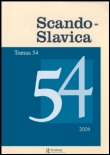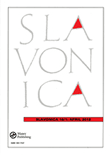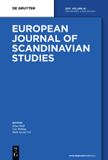
Vestnik Slavianskikh Kultur-Bulletin of Slavic Cultures-Scientific and Informational Journal
Scope & Guideline
Bridging Past and Present in Slavic Scholarship
Introduction
Aims and Scopes
- Interdisciplinary Studies of Slavic Cultures:
The journal emphasizes a multidisciplinary approach, integrating literature, history, folklore, and cultural studies to provide comprehensive analyses of Slavic cultures. - Cultural Heritage and Identity:
A significant focus is placed on the exploration of cultural identity, heritage preservation, and the evolution of cultural practices within Slavic communities. - Literary Analysis and Critique:
The journal publishes critical analyses of literary works, examining themes, narratives, and historical contexts that shape Slavic literature. - Folklore and Mythology:
Research on folklore, myths, and traditional narratives is a core area, highlighting their relevance in contemporary culture and their impact on identity. - Visual and Performing Arts:
The journal also covers studies related to visual arts, music, and performance, analyzing their role in expressing and shaping cultural narratives.
Trending and Emerging
- Modern Interpretations of Folklore:
There is a growing trend towards reinterpreting folklore in contemporary contexts, highlighting its ongoing relevance in modern cultural discussions. - Intercultural Dialogues and Exchanges:
Research focusing on intercultural interactions between Slavic cultures and other global cultures is on the rise, reflecting a broader interest in globalization and cultural exchange. - Digital Humanities and Cultural Studies:
The incorporation of digital tools and methodologies in cultural studies is emerging as a significant theme, allowing for innovative approaches to traditional research. - Ecocriticism and Environmental Themes:
Increasingly, the journal features discussions on ecological issues and their representation in Slavic literature and culture, addressing contemporary global challenges.
Declining or Waning
- Historical Narratives of the Soviet Era:
Research centered on Soviet-era narratives and folklore has decreased, possibly due to a shifting focus towards contemporary cultural issues and identities. - Traditional Gender Roles in Folklore:
While gender studies remain relevant, specific studies on traditional gender roles within folklore have waned, suggesting a shift towards more modern interpretations of gender in culture. - Regional Studies of Lesser-Known Slavic Cultures:
There is a noticeable decline in articles focusing on the cultural practices of less prominent Slavic groups, which may reflect a broader trend towards mainstream cultural topics.
Similar Journals

Scando-Slavica
Unveiling the Complexities of Cultural ExchangesScando-Slavica is a renowned academic journal published by ROUTLEDGE JOURNALS, TAYLOR & FRANCIS LTD, specializing in the rich interplay of Scandinavian and Slavic studies. With its ISSN 0080-6765 and E-ISSN 1600-082X, the journal has been a critical resource for scholars since its inception in 1954, covering a wide range of disciplines including archaeology, cultural studies, history, linguistics, and literature. As of 2023, it has consistently ranked in the third quartile across various categories, indicating its influential role in disseminating innovative research within the arts and humanities. With a focus on interdisciplinary dialogue, Scando-Slavica aims to foster a deeper understanding of cultural exchanges and linguistic connections, making it an essential read for researchers, professionals, and students interested in exploring the complexities of Nordic and Slavic interactions. While currently not an open access journal, its contributions have garnered substantial citations, bolstering its academic impact and relevance in a diverse scholarly landscape.

Lingua Montenegrina
Connecting Scholars to the Heart of Montenegrin LiteratureLingua Montenegrina is a distinguished academic journal dedicated to exploring and advancing the fields of Montenegrin language and literature. Published by the Institute of Montenegrin Language and Literature, this journal serves as a vital platform for researchers, educators, and students interested in the nuances and development of Montenegrin linguistics, literature, and cultural studies. With an ISSN of 1800-7007, it contributes significantly to the scholarly discourse in the region and beyond. While the journal operates under a traditional subscription model, it ensures that its readership has access to high-quality research that is pivotal for understanding Montenegrin identity and cultural expressions. The commitment of Lingua Montenegrina to rigorous academic standards and its focus on regional studies positions it as an essential resource for those looking to deepen their understanding of the Montenegrin language and its literary heritage.

SLAVONICA
Fostering Academic Dialogue on Slavic IssuesSLAVONICA is a distinguished academic journal dedicated to the exploration and analysis of Slavic studies, incorporating a wide array of cultural, historical, and linguistic perspectives. Published by Routledge Journals, Taylor & Francis Ltd, this journal serves as a critical platform for interdisciplinary scholarship, emphasizing the dynamic nature of Slavic cultures and languages. Though it currently does not offer Open Access, SLAVONICA is an important resource for researchers, professionals, and students seeking to engage with the latest academic discourse in the fields of Cultural Studies, History, Literature, and Linguistics, achieving a recognized place in the Q4 quartile across several categories as of 2023. With coverage spanning from 1994 to 2024, and its commitment to fostering academic inquiry, SLAVONICA plays a vital role in elevating the understanding of Slavic heritage and contemporary issues, making it essential reading for anyone interested in the complexities of this region.

WAFFEN-UND KOSTUMKUNDE
Investigating the Threads of History and IdentityWAFFEN-UND KOSTUMKUNDE is a distinguished journal published by VERLAGSHAUS WERNER HOFMANN KG, focusing on the intricate study of arms and costumes within the realms of visual arts and cultural history. With its ISSN 0042-9945, this journal provides a unique interdisciplinary platform dedicated to the exploration of textile and weapon narratives, reflecting on their historical and social significance. Although it has discontinued its coverage in Scopus as of 2017, it maintains a dedicated readership within the arts and humanities community, ranking #372 out of 470 in its category with a 20th percentile. The journal aims to inspire scholarly discourse by publishing innovative research and critical analyses that deepen our understanding of material culture. Interested readers and contributors can explore a wealth of insights through its archives and ongoing contributions from experts in the field, based in Sonnefeld, Germany.

Slavia Meridionalis
Unveiling new perspectives in Slavic academic discourse.Slavia Meridionalis is a distinguished open-access journal published by the Polish Academy of Sciences, Institute of Slavic Studies, dedicated to advancing scholarly discourse in the fields of Anthropology, Cultural Studies, History, Linguistics and Language, and Literature and Literary Theory. With its ISSN 1233-6173 and E-ISSN 2392-2400, this journal has made significant strides in promoting research since its inception in 2014. Operating from Warsaw, Poland, Slavia Meridionalis aims to serve as a pivotal platform for researchers and students alike, fostering interdisciplinary collaboration and knowledge dissemination. The journal holds respectable rankings in its various categories, some achieving Q3 status, which reflects its commitment to quality scholarship within the academic community. By providing open access to its readership, Slavia Meridionalis ensures that pivotal research is readily available for the global audience, thus enhancing its relevance and impact across diverse fields.

VOLKSKUNDE
Advancing Knowledge in Ethnographic ResearchVOLKSKUNDE is a distinguished academic journal dedicated to the study of folklore and cultural traditions, published by CENTRUM STUDIE DOCUMENTATIE based in Belgium. With an ISSN of 0042-8523, this journal serves as an essential platform for researchers, scholars, and students interested in the rich tapestry of cultural heritage and ethnographic research. Although currently not available as an open-access publication, VOLKSKUNDE is committed to disseminating high-quality scholarly articles that provide critical insights into the complexities of cultural practices across diverse societies. The journal’s objective is to foster academic discourse and stimulate inquiry into folklore studies, promoting a deeper understanding of cultural dynamics. By engaging with a broad range of topics within its scope, VOLKSKUNDE is an invaluable resource for anyone looking to deepen their knowledge in the field of folkloristics.

SLAVIC AND EAST EUROPEAN JOURNAL
Exploring the Depths of Slavic HeritageThe Slavic and East European Journal (ISSN: 0037-6752) is a distinguished publication focused on the rich tapestry of Slavic and Eastern European cultures, languages, and literatures. Published by the Ohio State University’s Department of Slavic and East European Languages & Culture, this journal serves as a vital platform for scholars and researchers keen on exploring linguistic diversity and cultural heritage in these regions. With a wide-ranging scope, the journal addresses significant topics within Cultural Studies, Linguistics, and Literature, currently categorized in Q4 and Q3 quartiles across various academic metrics. Although it does not offer open access, anticipation is high among academics seeking to contribute or access cutting-edge research that pushes the boundaries of understanding these complex fields. As it converges from 2009 to 2024, the Slavic and East European Journal continues to uphold its commitment to academic excellence and community engagement, making it an essential resource for anyone dedicated to the study of Slavic and Eastern European traditions.

OUD HOLLAND
Connecting History with Contemporary Artistic PracticesOUD HOLLAND is a prestigious journal published by BRILL, focusing on the rich history and developments in the visual arts and performing arts. With a historical lineage dating back to its initial publication years from 1883 and periodic revivals until 2024, this journal has maintained its relevance amidst evolving artistic discourse. It holds an impressive standing in the Arts and Humanities field, ranking 338 out of 667 in the Visual Arts and Performing Arts category, positioning it comfortably within the 49th percentile. The journal disseminates critical research and insightful articles that cater to scholars, professionals, and students dedicated to advancing their understanding of artistic heritage and contemporary methodologies. Though currently not open access, OUD HOLLAND represents an invaluable resource for those committed to exploring the multifaceted dimensions of art, offering access to a wealth of knowledge grounded in meticulous research and scholarship.

Art-Sanat
Advancing Knowledge in Art History and HeritageArt-Sanat is a distinguished open-access journal published by the Research Institute of Turkology at Istanbul University, focusing on various facets of art history, visual arts, and cultural heritage. Since its open-access launch in 2017, the journal has been dedicated to promoting scholarly communication and disseminating innovative research within the fields of Art History, Archaeology, and Conservation. With an impact factor that highlights its increasing prominence—ranking in the Q1 quartile for History and Visual Arts and Performing Arts—Art-Sanat provides a platform for researchers, professionals, and students to share high-quality studies. The journal's commitment to transparency and accessibility assures that its contributions are available to a global audience, fostering a community of inquiry in the rich and diverse artistic landscapes of Turkey and beyond. With a robust ranking in Scopus, it stands as a noteworthy resource that advances scholarly engagement and interdisciplinary dialogue in the arts and humanities.

European Journal of Scandinavian Studies
Fostering critical dialogues in Scandinavian cultural studies.European Journal of Scandinavian Studies is an esteemed journal published by Walter de Gruyter GmbH, dedicated to advancing scholarship in the fields of Cultural Studies, Linguistics and Language, and Literature and Literary Theory. Since its inception in 2010, the journal has been a pivotal platform for researchers and scholars, showcasing cutting-edge research and critical discussions pertaining to Scandinavian languages and cultures. With an ISSN of 2191-9399 and an E-ISSN of 2191-9402, the journal emphasizes accessibility to impactful academic work, despite its current non-open access model. While the journal is categorized within the Q4 quartile for Cultural Studies and Linguistics/Language, it has shown notable potential in ranking higher in its specialized domains, fostering a growing community of researchers invested in Scandinavian studies. The journal's office is located in Berlin, Germany, further enriching its European scholarly context. As it continues to evolve, the European Journal of Scandinavian Studies serves as a vital resource for academics seeking to engage deeply with the multifaceted aspects of Scandinavian culture and linguistics.